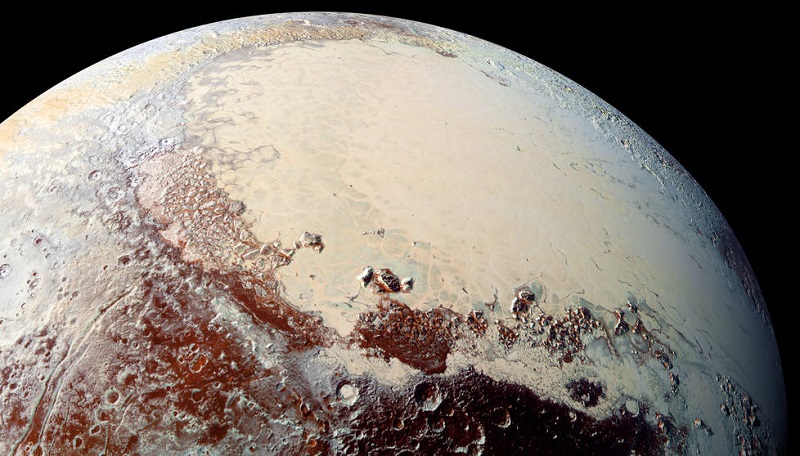
The region of Sputnik Planitia on Pluto shelters a glacier in a vast depression. An atypical structure that reveals the geological history of the dwarf planet.
What image will we keep of the passage of the probe New Horizons near Pluto in July 2015? Probably that of a large, heart-shaped region on the surface of the dwarf planet. This mission to the confines of the Solar System was rich in information for planetologists. Researchers from the New Horizons program, including Tanguy Bertrand and François Forget from the dynamic meteorological laboratory at the Pierre-et-Marie-Curie University and the CNRS, looked at an astonishing Pluto region called Sputnik Planitia, nestled in The left lobe of the „heart“ of the dwarf planet.
Sputnik Planitia is a vast plain of 1,000 kilometers in diameter covered with a smooth ice without craters (indicating that its formation is relatively recent, probably less than 10 million years ago). This glacier is in a depression probably born during a collision with a meteorite that left a deep crater in the crust of Pluto.
Tanguy Bertrand and François Forget studied how the ice, composed of nitrogen, methane and carbon monoxide, formed at the bottom of the crater. These three elements are normally in the gaseous state in the atmosphere of Pluto, whose temperature is about 40 kelvins (-233 ° C). But due to the large inclination of Pluto (nearly 60 °) and the latitude of the crater (its center is about 20 ° N), this region is colder than average, which favors the condensation of The atmosphere – consisting of 99.5% nitrogen – of solid ice at this location. The phenomenon is even self-amplified: at the bottom of the basin the pressure of the atmosphere is higher, so that the nitrogen condenses at a lower temperature than on the higher grounds outside the basin situated at the same latitude . The ice, formed at a higher solidification temperature, is therefore warmer in the crater than in the surrounding area. It dissipates more energy by thermal radiation (infrared), which lowers the temperature and ultimately promotes the condensation of the gas into ice.
The glacier, thus formed, measures several kilometers in thickness. In addition, it is denser than the crust of the dwarf planet, made up of water ice. Another team of researchers suggested that it may have contributed to breaking the surface, so that the bottom of Sputnik Planitia is now 6 to 13 kilometers lower than the surrounding areas.
This geological structure is so important that it creates an anomaly in the gravitational field of Pluto, which influences the dynamics between the dwarf planet and its Charon satellite. Since the two bodies are not perfectly spherical but rather ovoid, the tidal forces have a priori led the Pluton-Charon system to the most stable configuration, where the major axes of the two bodies are aligned (we speak of gravitational locking). But the formation of Sputnik Planitia disturbed this equilibrium and Pluto switched on its axis, bringing this region closer to the equator. Today, the Pluton-Charon system is evolving so that Sputnik Planitia is always near the antipode of Charon. The tipping of Pluto caused strong tensions on its surface and fractured its ice crust, which led to the formation of mountains and canyons photographed by New Horizons. This phenomenon of tilting is not unique in the Solar System: it would also have occurred on Mars, during the formation of the Tharsis volcanic complex about 3 billion years ago, or on the Moon during the Formation of the Procellarum basalt sea, about 4 billion years ago.
Another team of planetologists studied the conditions necessary for Pluto’s tipping. Has this depression caused the tipping? If one uses the simplest model of Pluto’s internal structure, a rocky core surrounded by a crust of water ice, the tipping of Sputnik Planitia towards the equator would only be possible if the glacier was 40 kilometers thick , A value far too large to be realistic. Indeed, a depression creates a priori an anomaly of negative mass (a mass deficit) that tends to align with the axis of rotation of the planet and not on the equator. On the contrary, a positive mass anomaly (for example a mountain mass) is required to cause a tilting towards the equator.
Another possibility would be that under the ice crust there is an ocean of liquid water that would have been brought closer to the surface under Sputnik Planitia as a result of the impact causing the depression. The density anomaly would then be sufficient to cause the dwarf planet to tilt. If this model is correct, Pluto


